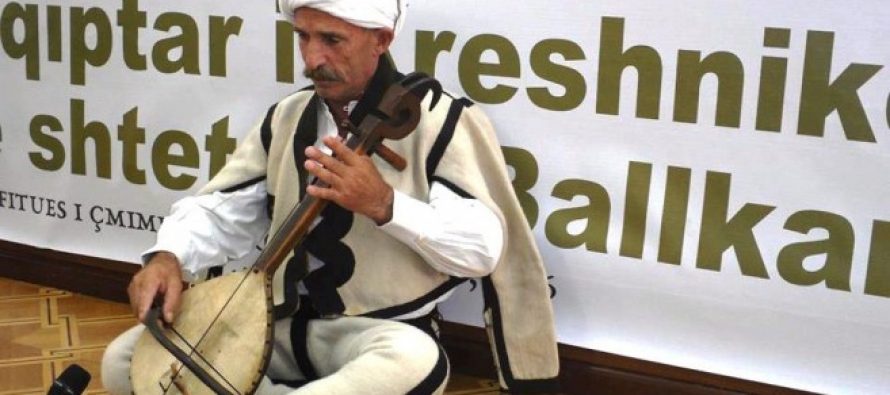The Highland Warrior – Samurai of Northern Albania

Story Highlights
- "The Highland Warriors Epics are an incredibly emotional, powerful and dramatic depiction of a contemporary society with ancient European cultural and linguistic roots. It gives a time, place, rhyme and reason to the origin, inspiration and reality of the Albanian people. The imagery representing the collective Albanian unconscious, formulates the basis of our traditional societal structure, the hierarchy and obligations to the shpi (home), vllazni (brotherhood) and fis (tribe)," says Albanian-American researcher Christopher Tushaj
Related Articles
By Christopher Tushaj
The Kà¢ngà« Kreshnikà«sh, or Songs of the Highland Warriors, are a fragile, living library of ancient Indo-European oral tradition of folk tales, myths, and legends in the highlands of Northern Albania. With the aid of the one-stringed lahuta (lute), a bard is tasked with keeping alive the memory of exemplary men and their heroic deeds in epic form, lauding the maintenance of the sacred values of besa (oath), burrni (chivalry), and trimni (bravery) expressed in their Kanun (tribal law). The Highland Warrior, a character inspired by the heroic archetype, is challenged through his journey to uphold his Albanian code of honor in the face of insurmountable odds. The listener is carried to a metaphysical world where the warrior wills through thick and thin for the protection of his most valuable possession: his identity and spirit. Regulated by his commitment to his moral character and devotion to the sacred tenets of the Albanian ethical value system of the Kanun: a strict code of chivalry that fuses elements of ancient pre-Christian European pagan traditions and religious tenets: righteousness, heroism, respect, honesty, self-sacrifice, fraternity, loyalty and honor. A Highland Warrior once taken this Besà«, is expected to keep his oath. “Shqiptaret vdesin dhe besen nuk e shkelin” Albanians will die before they break their honor “Ta jap shpirtin, ta fali djalin, por mbi besà« nuk shkeli...” I’ll give you my soul, and my own son, but I’ll never break my word.
The Highland Warriors Epics are an incredibly emotional, powerful and dramatic depiction of a contemporary society with ancient European cultural and linguistic roots. It gives a time, place, rhyme and reason to the origin, inspiration and reality of the Albanian people. The imagery representing the collective Albanian unconscious, formulates the basis of our traditional societal structure, the hierarchy and obligations to the shpi (home), vllazni (brotherhood) and fis (tribe). These stories speak to our deepest psychological motivations, our inner archetypes, helping others to bridge the gap between the virtues of myth, legend and man. They transmit the will, heroic resilience and determination of the Albanian spirit and grant the listeners a guide to righteousness during the trials and tribulations in our often-difficult history. These characters mirror the fading ember of a once roaring fire for their identity, a source of great pride and self-respect.
The Kenge Kreshnikesh communicates the accounts of people, ordinary and extraordinary, mythical and legendary, who lived true to this faith, even to the point of their own demise. In contrast to the Samurai, pertaining only to a middle and upper warrior class who accompanied the elite in Feudal Japan, principles of the Highland Warrior, applied to all members of Albanian society: men, women and children. In this case, the Highland Warrior could be a cousin, uncle, brother or father (and in many cases, women, lest us not forget the story of Nora from the Kelmend tribe). These songs mirror real life events as well: what about the young boy, conscious of his duty to uphold his personal and family honor, sacrificed his life to save a Jew who was at gunpoint by the Nazis during World War II? What about the father in Kadare’s book who murdered his own son, honoring the sacred covenant of protecting the guest at any cost? The list goes on and on, and the Kenge Kreshnikesh are exist to immortalize these for generations to come.
The Highland Warriors hold the potential to be perfect role model for Albania’s international recognition, on par with the strong associations of Western mantras when uttering the words ‘Ancient Greece’ (birth place of democracy). The Kenge Kreshnikesh, like the Homeric Epics of Iliad and the Odyssey, mirrors true the structure of a pre-state tribal society both within and outside of the oral tradition. Albania is now on the road to being recognized as the crucible for the infancy stages of modern democracy. Kazuhiko Yamamoto, Japanese medical doctor, professor of medical anthropology and author of the Ethical Structure of the Albanian Customary Law, proposes that the ethical structure of the Kanun to be the original foundation of ethics in human society today, noting that the structure of the Homeric society (oath, honor, guest, blood, and food) consists found in the Iliad and Odyssey belongs to the same category of societal ethics without state power.
Even the tongue of the Highland Warriors speaks truths about Albania’s connection to its’ pre-Greek Homeric antiquity. Academic study of Albanian morphology and Proto-Albanian can highlight and analyze the rare, archaic morphological features of the Gheg dialect preserved in the Highland Epics, possibly revealing groundbreaking information for historical linguists engaged in the reconstruction process of Proto-Indo-European (PIE), the mother tongue of over 440 languages stretching from China to Europe. Conducting research on last glimpses of authentic performances of the Highland Epics in the Gheg dialect (the oldest dialect of the oldest surviving Indo-European language in Europe) can help validate Albanians as a people as being recognized as an integral part of their undeniable European identity. Albania’s cultural recognition relies upon a concise narrative by which fully encompasses all of the Albanian people, what makes them Albanian, and the highland epics have this potential. It can serve for many functions: towards integration into European Union, strengthening our ability of custom tailored rule of law, governance and democracy development projects within Albania. The Kà¢ngà« Kreshnikà«sh, the oldest surviving syncretic art form in Europe, has valuable potential for awakening our consciousness to an invaluable cultural wealth, that is, the power of belief and faith to make a change for one’s self and their future. This cult of heroes has persisted through obscurity and over millennia, but this ancient art form, along with its spiritual connection, are hanging on by the small threads of the memory of a time once before. This tradition, along with its beloved ethical value system, are under renewed threat and dying in front of modern challenges: it is safe to say that an essential part of the Albanian identity and an intangible piece of world cultural heritage is set to be lost forever.




